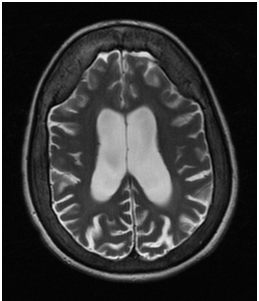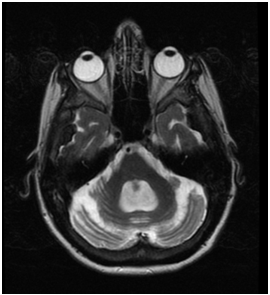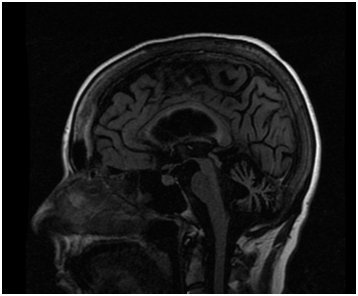Session Information
Date: Sunday, October 7, 2018
Session Title: Choreas (Non-Huntington's Disease)
Session Time: 1:45pm-3:15pm
Location: Hall 3FG
Objective: To report a case of a 51-year-old woman with recurrent basal cell carcinoma, severe photosensitivity, and progressive chorea and ataxia caused by xeroderma pigmentosum (XP).
Background: XP is an autosomal recessive (AR) disorder associated with photosensitivity and skin malignancies. Severe cases may present with mental retardation, dwarfism, and hypogonadism. XP-A to G are due to mutations in nucleotide excision repair (NER) of ultraviolet (UV)-induced DNA lesions. Neurologic signs are found in 20% of cases. Presentations include chorea, ataxia, and peripheral neuropathy. Chorea is rare in AR ataxias, except for ataxia telangiectasia and AOA1/2; thus, XP should be on the differential for patients with chorea and AR ataxia. MRI imaging often demonstrates diffuse atrophy; two reports note hyperostosis frontalis interna. Considerations for the pathophysiology of the neurologic syndromes include transcriptional disturbances given roles in NER and transcription initiation.
Methods: A 51-year-old woman presented with chorea and ataxia. Gait ataxia and choreiform movements in her hands began at age 39. At 46, she developed dysarthria and, at 47, generalized chorea. Mild cognitive changes have developed. She has a history with 8 basal cell carcinomas, severe photosensitivity, and premature menopause in her 30s. Her paternal great-aunt had abnormal movements and photosensitivity. Her exam was notable for skin freckling, scanning dysarthria, mild increased tone, moderate chorea of the face, trunk and limbs, and ataxic gait. MRI brain showed diffuse cerebral and cerebellar atrophy and hyperostosis frontalis interna. Huntingtin and Fragile X testing were negative. Peripheral smear, copper and rheumatologic studies, and GAD65 Ab were negative.
Results: Exome sequencing revealed two variants of uncertain significance in the ERCC4 gene (16:14029554 C>G, p.Arg589Gly, MAF 0.002%; 16:14041570 T>C, p.Ile706Thr, MAF 0.14%) as well as a previously reported mutation (16:14041848 C>T, p.Arg799Trp, MAF 0.04%) consistent with a likely pathogenic diagnosis of XP complementation group F. We suspect p.Ile706Thr to be a rare polymorphism based on its higher minor allele frequency relative to the other two variants. Supportive treatment and UV light damage prevention are recommended.
Conclusions: XP is more commonly associated with ataxia, but case reports note associations with chorea. Our patient had recurrent basal cell carcinomas, skin sensitivity, and hypogonadism that are common in XP. XP should be considered in patients with chorea and ataxia with a significant dermatologic history and hypogonadism.
References: Carre G, Merelli C, et al. “Xeroderma pigmentosum complentation group F: A rare cause of cerebellar ataxia with chorea.” Journal of the Neurological Sciences. 2017; 37: 198-201. Sijbers, A. M., van Voorst Vader, P. C., Snoek, J. W., Raams, A., Jaspers, N. G., & Kleijer, W. J. (1998). “Homozygous R788W point mutation in the XPF gene of a patient with xeroderma pigmentosum and late-onset neurologic disease.” Journal of Investigative Dermatology, 110, 832–836.
To cite this abstract in AMA style:
A. Jocson, K. Ngo, D. Togasaki, B. Fogel. Chorea and Ataxia as Manifestations of Xeroderma Pigmentosum: A Case Report [abstract]. Mov Disord. 2018; 33 (suppl 2). https://www.mdsabstracts.org/abstract/chorea-and-ataxia-as-manifestations-of-xeroderma-pigmentosum-a-case-report/. Accessed December 20, 2025.« Back to 2018 International Congress
MDS Abstracts - https://www.mdsabstracts.org/abstract/chorea-and-ataxia-as-manifestations-of-xeroderma-pigmentosum-a-case-report/



